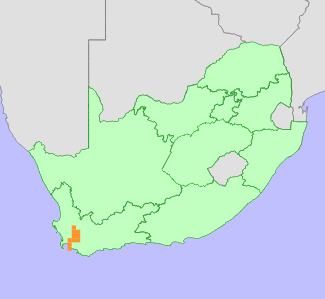|
Scientific Name | Leucadendron sessile R.Br. |
Higher Classification | Dicotyledons |
Family | PROTEACEAE |
Synonyms | Leucadendron humifusum E.Phillips |
Common Names | Western Sunbush (e) |
National Status |
Status and Criteria | Near Threatened B1b(iii)+2b(iii) |
Assessment Date | 2020/04/07 |
Assessor(s) | A.G. Rebelo, D. Raimondo & L. von Staden |
Justification | Leucadendron sessile is an endemic species to South Africa's Fynbos Biome. It has an extent of occurrence (EOO) of 3477 km², and an area of occupancy (AOO) of 356 km², and is know from 20-30 locations. There has been an overall loss of 15% of habitat, with 1% of this loss taking place in the past 24 years. Despite habitat transformation being low, there is ongoing severe degradation of its habitat taking place as a result of invasive alien plant species spread and due to drought related mortality. This species therefore nearly meets the thresholds for listing as Vulnerable under Criterion B. |
Distribution |
Endemism | South African endemic |
Provincial distribution | Western Cape |
Range | This species' range stretches from Witzenberg to Slanghoek and Jonkershoek to Kogelberg, in the Western Cape Province of South Africa. |
Habitat and Ecology |
Major system | Terrestrial |
Major habitats | Winterhoek Sandstone Fynbos, Kogelberg Sandstone Fynbos, Hawequas Sandstone Fynbos, Elgin Shale Fynbos, Cape Winelands Shale Fynbos, Breede Shale Fynbos, Boland Granite Fynbos, Western Coastal Shale Band Vegetation |
Description | It occurs on granite clays on mountain slopes, 10-600 m. Mature individuals are killed by fires, and only seeds survive. Seeds are relased after ripening, and collected by rodents and stored in underground caches, where they are protected from fires. It is dioecious, with insect-pollinated male and female flowers occuring on separate plants. |
Threats |
| This species has lost habitat in the past to afforestation, loss to alien plant invasion, and too frequent fire and drought-related mortality are ongoing. |
Population |
While there are a number of large subpopulations spread across its range, the population is declining as a result of ongoing habitat degradation.
|
Population trend | Decreasing |
Conservation |
| An estimated 37% of the population occurs within protected areas, however, there is still decline taking place within these areas as a result of competition with invasive alien plants. |
Notes |
| Taxonomical problems need to be resolved as there may be two separate taxa. |
Assessment History |
Taxon assessed |
Status and Criteria |
Citation/Red List version | | Leucadendron sessile R.Br. | NT B1b(i,ii)c(iv)+2b(i,ii)c(iv) | Raimondo et al. (2009) | |
Bibliography |
Goldblatt, P. and Manning, J.C. 2000. Cape Plants: A conspectus of the Cape Flora of South Africa. Strelitzia 9. National Botanical Institute, Cape Town.
Manning, J.C. and Goldblatt, P. 2012. Plants of the Greater Cape Floristic Region 1: The Core Cape Flora. Strelitzia 29. South African National Biodiversity Institute, Pretoria.
Raimondo, D., von Staden, L., Foden, W., Victor, J.E., Helme, N.A., Turner, R.C., Kamundi, D.A. and Manyama, P.A. 2009. Red List of South African Plants. Strelitzia 25. South African National Biodiversity Institute, Pretoria.
Rebelo, T. 2001. Sasol Proteas: A field guide to the proteas of southern Africa. (2nd ed.). Fernwood Press, Vlaeberg, Cape Town.
|
Citation |
| Rebelo, A.G., Raimondo, D. & von Staden, L. 2020. Leucadendron sessile R.Br. National Assessment: Red List of South African Plants version 2024.1. Accessed on 2025/12/23 |
 Comment on this assessment
Comment on this assessment

